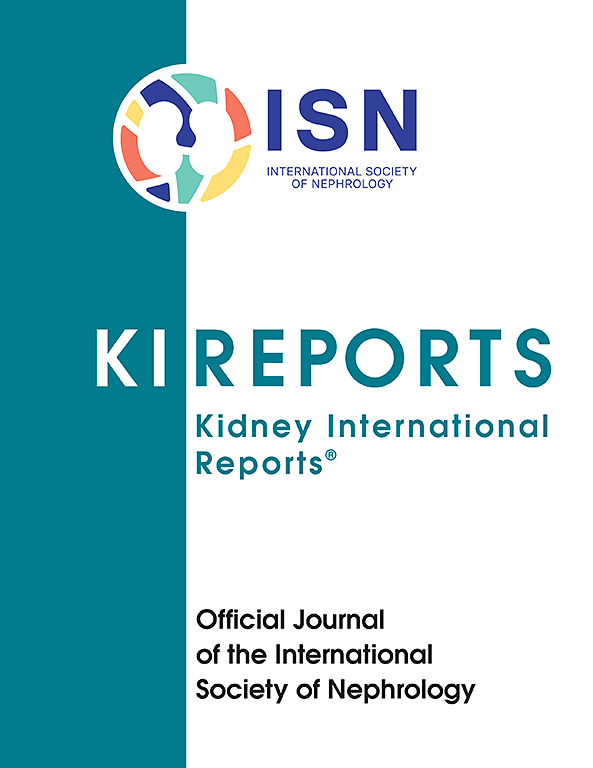髓过氧化物酶免疫染色在新月形肾小球肾炎患者免疫沉积中的应用
IF 5.7
2区 医学
Q1 UROLOGY & NEPHROLOGY
引用次数: 0
摘要
包细胞免疫月牙性肾小球肾炎(GN)几乎等同于抗中性粒细胞胞浆抗体(ANCA)相关疾病。免疫复合物沉积的病例造成了一个诊断难题,导致怀疑并发感染或自身免疫性疾病。小病例系列已证实膜性肾病(MN)和anca相关疾病患者的免疫沉积物中存在髓过氧化物酶(MPO)。然而,MPO染色表征新月形GN免疫沉积的特异性尚未得到全面评估。方法对143例肾活检组织进行MPO免疫染色,包括少免疫月牙体GN (n = 15)、合并免疫复合月牙体GN的ANCA (n = 20)、不合并月牙体的MN (n = 24)、心内膜相关月牙体GN (n = 25)、hydralazine相关月牙体GN (n = 11)、不合并磷脂酶A2受体(PLA2R)的月牙体GN和MN (n = 38)和合并PLA2R (n = 10)。4名盲法病理学家对MPO免疫组化(IHC)的阳性、特征和位置进行了评估。结果无PLA2R的双月牙GN和MN患者中,84.2%为MPO-IHC阳性。带有系膜IgG的新月形GN 40%呈MPO-IHC阳性。与肼暴露相关的新月GN有72.7%呈MPO-IHC阳性。所有缺乏免疫的新月形GN、心内膜炎相关病例和已知抗原的MN病例均为MPO阴性。结论月牙型GN血清学阳性的肾小球免疫沉积在大多数病例中表现为免疫沉积模式的MPO阳性。因此,月牙形GN阳性患者的肾小球免疫复合物代表MPO-IgG免疫复合物,应被视为一种疾病,而不是第二个疾病过程。本文章由计算机程序翻译,如有差异,请以英文原文为准。

The Utility of Myeloperoxidase Immunostaining to Characterize Immune Deposits in Patients With Crescentic Glomerulonephritis
Introduction
Pauci-immune crescentic glomerulonephritis (GN) is nearly synonymous with antineutrophil cytoplasmic antibody (ANCA)–associated disease. Cases with immune complex deposition create a diagnostic conundrum leading to suspicion for concurrent infection or autoimmune disease. Small case series have demonstrated myeloperoxidase (MPO) in the immune deposits in patients with membranous nephropathy (MN) and ANCA-associated disease. However, the specificity of MPO staining to characterize immune deposits in crescentic GN has not been thoroughly evaluated.
Methods
We performed MPO immunostaining of 143 kidney biopsies, including pauci-immune crescentic GN (n = 15), ANCA with immune-complex crescentic GN (n = 20), MN without crescents (n = 24), endocarditis-associated crescentic GN (n = 25), hydralazine-associated crescentic GN (n = 11), and concurrent crescentic GN and MN without phospholipase A2 receptor (PLA2R) (n = 38) and with PLA2R (n = 10). MPO immunohistochemistry (IHC) was evaluated for positivity, character, and location of MPO immune deposits by 4 blinded pathologists.
Results
In patients with dual crescentic GN and MN without PLA2R, 84.2% were MPO-IHC positive. Crescentic GN with mesangial IgG was MPO-IHC positive in 40%. Crescentic GN related to hydralazine exposure was MPO-IHC positive in 72.7%. All cases with pauci-immune crescentic GN, endocarditis-associated cases, and MN cases with known antigens were negative for MPO.
Conclusion
Our study demonstrated that glomerular immune deposits in patients with crescentic GN with positive MPO serology demonstrated MPO positivity in the pattern of immune deposits in the majority of cases. Glomerular immune complexes in patients with MPO-positive crescentic GN therefore represent MPO-IgG immune complexes and should be thought of as one disease rather than a second disease process.
求助全文
通过发布文献求助,成功后即可免费获取论文全文。
去求助
来源期刊

Kidney International Reports
Medicine-Nephrology
CiteScore
7.70
自引率
3.30%
发文量
1578
审稿时长
8 weeks
期刊介绍:
Kidney International Reports, an official journal of the International Society of Nephrology, is a peer-reviewed, open access journal devoted to the publication of leading research and developments related to kidney disease. With the primary aim of contributing to improved care of patients with kidney disease, the journal will publish original clinical and select translational articles and educational content related to the pathogenesis, evaluation and management of acute and chronic kidney disease, end stage renal disease (including transplantation), acid-base, fluid and electrolyte disturbances and hypertension. Of particular interest are submissions related to clinical trials, epidemiology, systematic reviews (including meta-analyses) and outcomes research. The journal will also provide a platform for wider dissemination of national and regional guidelines as well as consensus meeting reports.
 求助内容:
求助内容: 应助结果提醒方式:
应助结果提醒方式:


